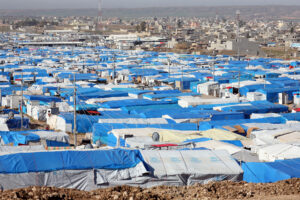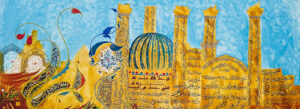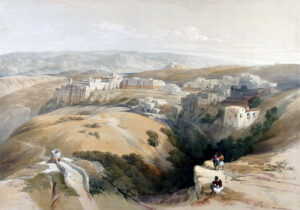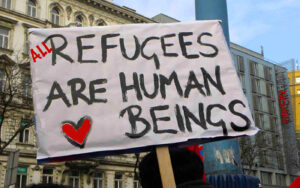Taking us along the 24 kilometers of the wall from gate to gate, To the City is a compendium not only of Turkey’s unavoidable social and political deterioration over the last decade, but also a sober inquiry into the violence of the past, both recent and distant, making clear the misconception, often reinforced by Turkish commentators, that the ills of the country are simply a result of Erdoğan’s divisive politics.
To the City: Life and Death Along the Ancient Walls of Istanbul by Alexander Christie-Miller
HarperCollins UK /Simon & Schuster US
ISBN: 9780008416041
Arie Amaya-Akkermans
In the winter of 2021, I came for the first time to the Monastery of the Mother of God at the Spring, known as Balıklı Rum, near Silivri Gate, one of the gates along the Theodosian Walls in Istanbul, erected in the 5th century CE. I was there with Turkish artist Kanat Akar to shoot a film about the Karamanlides, a Turkish-speaking Greek Orthodox population from Central Anatolia, since the largest number of graveyards inscribed in their extinct dialect to be found anywhere are in the courtyard of the monastery. Against the background of the city walls and the monastery, which date back to the early Byzantine period, I kept wondering whether any Greeks still lived within the old city walls. The Yedikule neighborhood, after all, was the first place in the city the Greeks settled after they were allowed to return following the Ottoman conquest, and until recently, it was still home to many non-Muslims.
Almost a decade earlier, British journalist Alexander Christie-Miller asked himself the same question. He’d been living in Istanbul as a correspondent for The Times and began wondering about the afterlives of the old Byzantine walls and the peoples who lived around them. In his recent book, To the City: Life and Death Along the Ancient Walls of Istanbul (2024) — whose title makes reference to the Greek etymology of the city’s Turkish name, ‘eis tin polin’ (to the city) — he recounts his disappointment after a first visit to the Gate of Spring, as Silivrikapı was known in Byzantine times: “I went to the monastery and spoke to the priest there who, after I had explained my project, politely but firmly deflected me. When I asked him if there were any Greeks still living around the walls, he said he didn’t think so, then added, almost as an afterthought, that he himself had grown up in Yedikule, just down the road.”
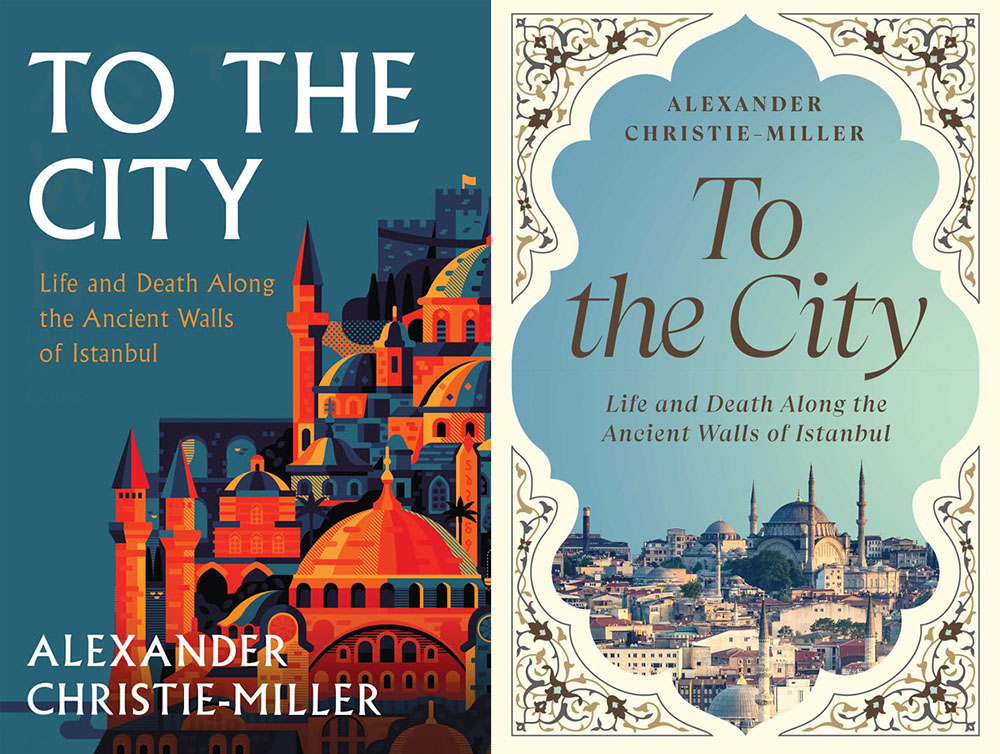
Our experience wasn’t very different. We weren’t permitted to film at the monastery without official permission, and so were quickly shooed away. To come back, we had to first secure a letter from the Ecumenical Patriarchate — impossible without connections — specifying the date and time of the shooting, signed and stamped by the Deputy Patriarch himself. The whole process is proof of the delicate politics of minorities in the city, where church affairs are kept at a distance from the public eye. But even armed with the letter, the tight-lipped priests made no effort to inquire about our business there, though they watched our every move from afar. It was only when we went down to the “ayazma,” the spring that gives the monastery its name, that a curious onlooker noticed us and decided to ask what we were filming. But he wasn’t a Greek priest — or a “Roman,” as the Greeks of Anatolia call themselves. He was an Arab Christian from Antioch, who had come to work as a janitor in the monastery, and he knew little about the unhappy, but long and illustrious, history of Greeks in the neighborhood. After the Istanbul pogroms in 1955, the poor Christian communities around the walls experienced intense destruction. And the janitor’s story was an illustration of the complex ways that the past — both ancient and recent — works upon the present. Born in the Christian heartland of Antioch’s hills, he experienced discrimination as a “Greek,” even though as a Levantine Arab he had little connection to Anatolian Greeks. Later, he found his way to Istanbul where he was dubbed an Arab by Turks, and a Turk by the Greek community. He told us that he hoped to find his way to Germany, where many Antiochian Christians have lived for generations.
In Christie-Miller’s narrative as well, characters often reveal themselves as unpredictably larger and more complicated than the story of the ancient walls. When the British journalist returned to Silivri Gate, this time it was to meet with members of a different minority: Kurdish activists affiliated with HDP, the People’s Democracy Party, the main, officially recognized pro-Kurdish party (currently represented in parliament by the People’s Equality & Democracy Party, after several attempts of the government to abolish it). He relays the story of Tarık, a former baggage security checker at Istanbul Airport, which begins with his arrival in Silivrikapı as a 6-year-old from the Van province in eastern Turkey, and ends with his arrival in California. In between, he flees Turkey and climbs over a seven-meter-high wall dividing Mexico from the United States, his journey a series of tales of political persecution, illness, poverty, displacement and crony capitalism that have become synonymous with Turkey and the government of Tayyip Recep Erdoğan.
But Christie-Miller doesn’t succumb to presentism. Instead, his book is interwoven with the destinies of different communities whose fates are all connected to the city walls, even if they never meet face to face. “Just as the Greeks had fled from the areas around the walls,” he writes, “so [Tarık’s] family had fled into them in search of refuge from the oppression and bloodshed that was gripping the south-east during the mid-1990s as a result of the war between the Turkish state and the Kurdish separatist PKK.” The tale of Silivrikapı, a place as distant as possible from the contemporary narratives of nostalgia and heritage associated with Istanbul, opens up, through Tarık’s story, a harrowing episode of urban development surrounding the construction of the new Istanbul airport, and the massive environmental destruction, labor violations and political calculations that came with it.
To the City is not a book in the genre of what can be called “Byzantine-wall-literature,” those tourist-friendly guides written by foreigners, which tend to glorify the ancient past at the expense of the present, offering up a catalog of ruins that can be visited along with a detailed map of their locations. But it is still nevertheless a catalog of ruins: The ruins of a political present that overlaps with the physical erosion of the Byzantine and Ottoman walls that envelop it. A curious and incisive reporter of political affairs in Turkey during the turbulent period between the constitutional reform of 2010 and the failed coup d’etat in 2016, Christie-Miller writes not simply as an observer. For better or worse, he became quite involved in the life within these walls: volunteering at an animal shelter near Tabak Kapı in Kazlıçeşme, interviewing people facing eviction in Tokludede, bemoaning the crude, botched restoration of the walls around Belgradkapı.
It is indeed near Kazlıçeşme, by the Tanners’ Gate, once a place for tanneries and slaughterhouses, that Christie-Miller deploys all the power of his intricate storytelling. Moving back and forth between remote past and wounded present, he tells a story without which no account of Istanbul would be complete, that of the city’s undying love for its population of stray animals. Starting out with his time volunteering at a dog shelter in the area of the tanneries, Christie-Miller takes us on a long elliptical journey, from the Lower Paleolithic domestication of the dog, to local Islamic folklore, to Orientalist if not outright racist accounts of European travelers from earlier centuries about stray animals in the city, and the different accounts of dogs being exiled to the island of Sivriada in the late Ottoman era. But there’s no happy ending. The tale ends with the murder of a middle aged woman who looked after stray cats in Beyoğlu district in the 2010s.
It was precisely there, in Kazlıçeşme, that I first became aware of the painful afterlives of the city walls in 2021. Resigned to a lost day of work after being shooed away from the monastery, we went down to Kazlıçeşme by the Marmara Sea, in order to get a view of the sea from a part of the city that remains unknown to most Istanbulites. The sights were arresting in their absurdity: The heavily polluted empty beach, a horizon littered with shipping vessels waiting to enter the Bosphorus Strait against the blue silhouette of the Princes Islands. Behind us, a section of the Theodosian Walls near Belgradkapı that has almost vanished was covered with billboards and scaffoldings. There you can also catch a glimpse of the city’s present: Long rows of sprawling glass and steel towers, developments planned in better times and that now lie either unfinished or empty.
Yet the city walls — though in a state of terrible disrepair between neglect, incomplete restorations and failed heritage policies — are nowhere near dead. And this is where Christie-Miller’s book differs vastly from the Hellenocentric view of Byzantine scholarship that regards them as the unpopulated, forfeited relics of a glorious past. In To the City, the kilometers-long walls are not simply a testimony to the Greek past, but are very much alive in the present: “There were Syrian refugees, Kurds displaced by the fighting in the south-east, and communities torn apart by profit-grabbing developers. I came to see the walls as a symbol of resistance to all these forces of upheaval; they seemed less an architectural feature of the city than a geological one that time had yet to erode, protruding from the past like an outcrop of rock anchoring an eroding headland, the remnants of an older world clinging in their lee.”
Christie-Miller tells TMR about the genesis of the book: “Originally I had planned to write an essay about the city walls as part of what would have been a collection of articles. However, when I began researching and visiting the walls, I realized that the topics and associations bound up with them — geographically, politically, and historically — were so rich and broad that this should be a book. I did not set out with a thesis, but with a feeling of a place and an array of avenues and associations which I wanted to connect and hold up to the reader in order to give a sense of that place.” But the fact that he chose to let the present inhabitants of the walls tell their own stories rather than be consumed by the historical weight of a monument shouldn’t deceive us into believing that this is a tale of hope — even if there are strong elements of legend, laughter and paradox.
To the City is not a book in the genre of what can be called “Byzantine-wall-literature,” those tourist-friendly guides written by foreigners, which tend to glorify the ancient past at the expense of the present, offering up a catalog of ruins that can be visited along with a detailed map of their locations. But it is still nevertheless a catalog of ruins.
Taking us along the 24 kilometers of the wall from gate to gate, the book is a compendium not only of Turkey’s unavoidable social and political deterioration over the last decade, but also a sober inquiry into the violence of the past, both recent and distant, making clear the misconception, often reinforced by Turkish commentators, that the ills of the country are simply a result of Erdoğan’s divisive politics. Many of the personal stories recounted in the book are so bitter, so cruel and so harrowing, that even for someone like myself, who has spent a quarter of his life in Istanbul and is fluent in the language of irony and comic despair, it is difficult to reconcile all these facts with our own lives. It’s not so much that stories like these were unfamiliar to Istanbulites in the previous decade, but the surgical precision of Christie-Miller’s journalistic recounting leaves no additional room for myth, wishful thinking or nostalgia.
The absence of hope, however, is neither an act of submission to the material of reality nor a lack of compassion. It is rather a reaffirmation of the resilience of his characters, from a university lecturer, to a grieving father or an addiction survivor. Their lives couldn’t be more different, but they’re still connected through their relationship with the walls and their commonality with them, for they, too, are invisible in the grand narrative of modern Turkey. Just as the city walls in the historical peninsula are now distant from the city’s symbols of power, the lives of these characters have become obscured in the process of shifting the city’s narrative into its current iteration. But Christie-Miller attempts to recenter them both: “I thought of the span of history contained in those stones, how they seemed so utterly divorced from the realities and pressures of the people who now lived beneath them, but also obscurely connected to them in a way that touched the soul of this city.”

Though the storytelling, as mentioned before, is surgical, the style of the book is more vivacious. By means of navigating the porous space of the Byzantine walls — a combination of ruins, displaced peoples, real estate speculation and folklore — the writer’s perspective becomes porous, irregular and hesitant as well. At times, he tries to imagine different destinies for his characters, even if they never come to pass, and in reconstructing their steps, sometimes he himself becomes lost in a maze of historical references, changing political events and reflections after the fact. But it is precisely this sense of disorientation that gives the book a profoundly human character: “And yet I found that as my knowledge grew, my confidence diminished.” The book was completed long after Christie-Miller left Istanbul, following the attempted coup d’etat in 2016.
In this same spirit, one of the most captivating episodes in To the City does not come from the encounters of the journalist with the present-day inhabitants of the walls, but rather, from a reconstruction of the events of the siege of Constantinople in 1453, after which the city became the center of a new empire. Most of the surviving accounts of Mehmet’s eight-week-long siege of the city, according to Christie-Miller, come neither from Greek nor Ottoman sources, but from foreign eyewitnesses, such as an Italian bishop, a Venetian doctor or a classicist from Brescia. These blurry testimonies, written not from the perspective of the protagonists, paint a chaotic picture of irregular warfare, political intrigues, luck, betrayal, apocalyptic visions and confusion. This narrative is important for the purpose of the book because it unmakes the belief that Istanbul’s fractured present is a recent political condition.
In Christie-Miller’s conversation with Mihail Vasiliadis, the editor of the local Greek newspaper Apoyevmatini, to whom he turned in search for information about the Greeks of Yedikule that he failed to obtain at the monastery, we learn about the different timescales that are present in Istanbul, and the timeline of the city’s foundation which continues to be politically contentious, depending on whom you ask. Vasiliadis tells Christie-Miller: “‘Sadly, there’s this weird mentality: some people think Istanbul was built in 1923, some in 1453. Others in 333. Some others think it was during the period of Midas in 400 BC… That’s wrong too. Istanbul’s history began five thousand years ago.’ He mentioned the recent discovery of footprints thousands of years old that had been found by archaeologists during excavations accompanying the construction of a new tunnel under the Bosphorus. ‘I’m still thinking about that five-thousand-year-old footprint.’”
These historical detours into the deep past of the city aren’t simply a footnote or an embellishment to make up for the tormented lives destroyed by political persecution and economic crises, but a serious recognition, on the part of the author, that in spite of the cruelty of the present, the final word about Istanbul and the city walls hasn’t yet been uttered, and it would be unwise to suggest otherwise. For a city that has lived so many lives, and restarted again just as many times, it is possible that there are different futures in store, even if they are not visible at the moment. “It troubled me somewhat after finishing the book,” Christie-Miller told TMR, “that the overall tone was quite pessimistic. In a way, writing the book, or perhaps distance from Turkey, went a long way in exorcizing my pessimism about the country and its direction. If I were writing the book again now it might be a shade more optimistic.”
And yet for all its sober-mindedness, there’s still a strong element of subtle optimism here, present in the form of what I would call multi-temporal writing. Most narratives about the city, and particularly the walls, are centered on a single perspective, such as the Byzantine or Ottoman pasts, Islamic heritage, urban gentrification or displacement. But Christie-Miller combines all of these perspectives together to produce a multi-temporal account that resembles a contemporary archaeology: The Byzantine past, the long Ottoman era with its mosques, gardens, fountains and tea houses along the walls that survive as public spaces to this day, the departure and arrival of different generations of refugees, and the violent heritage policies of Turkey, all become part of a single, thick assemblage of human and non-human elements that coexist against all odds and that in their togetherness have demonstrated exceptional resilience throughout time.
Still, it would be a terrible omission to ignore the fact that the walls are primarily a historical monument, and one that is severely endangered. This threat is not only the result of the erosion of time, but primarily of the country’s selective heritage policies, favoring a pseudo-Ottoman aesthetic that thrives on mediocre restorations, state propaganda and intentional destruction. There’s also the pragmatic consideration that the vast area of the walls simply presents too much of a financial burden for any modern state to shoulder. And although there are significant restoration works being carried out by the Istanbul Metropolitan Municipality, they are limited to short sections thereof. The destruction of communities along the walls is symptomatic of their neglect, and vice versa. It is unlikely that there will be any changes to this process in the future: that is, abandonment followed by restoration as a different and further form of destruction.
The city walls with their landmarks and gates serve both as metaphor and structure in To the City, holding historical space glued together not as a smooth continuity, but as a fluid stratigraphy of events, leaving permanent marks in the landscape. Yet as Christie-Miller writes in reference to the artificial and archaeologically erroneous restorations of the wall sections near the historical peninsula in pursuit of the neo-Ottoman past, “Every nation performs this kind of myth-making, but rarely with the kind of destructive, amnesiac eagerness I had seen in Turkey.”
This falsification of the past, a trademark of Turkey’s heritage policy, is lethal to the preservation of the same past it attempts to violently remake, which unsurprisingly comes hand in hand with fresh cycles of violence against the peoples living on the edges of the monument. It is they who are its living memory, one that can potentially be lost forever.













